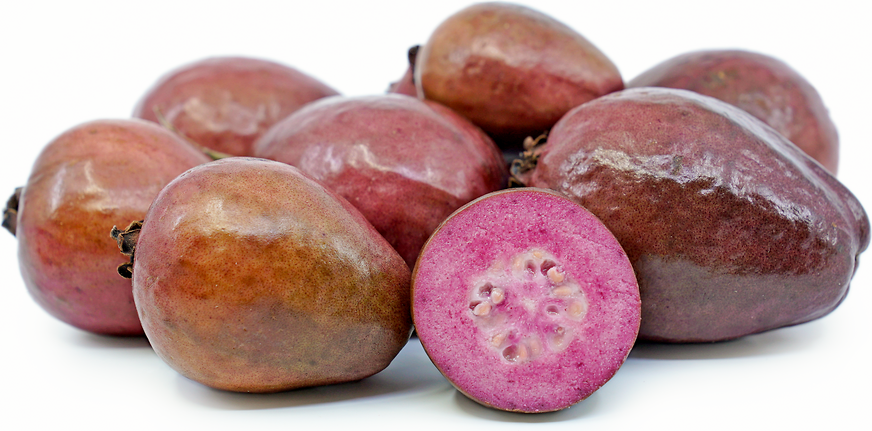


Red Malaysian Guavas
Estimated Inventory, lb : 0
Description/Taste
Red Malaysian guavas are a larger variety, averaging 8 to 10 centimeters in diameter, and have a round to oval shape. The skin is thin, bumpy, glossy, and textured, ripening to a dark purple-brown hue. Underneath the surface, the flesh is soft, semi-granular, tender, and aqueous with variegated shades of pink, purple, and white. The vibrant flesh also encases a few round, ivory seeds that are edible but are typically swallowed whole due to their hard and dense nature. Red Malaysian guavas are highly aromatic and have a sweet-tart, complex flavoring comprised of floral, fruity, and musky notes. The fruits also contain low acidity, reducing the sour, tannic flavor commonly associated with other guava varieties.
Seasons/Availability
Red Malaysian guavas are available in the fall through early spring in the United States. In tropical regions of Southeast Asia, the trees may produce fruits multiple times a year, with a peak season in the northeast monsoon season.
Current Facts
Red Malaysian guavas, botanically classified as Psidium guajava, are a rare, sweet-tart variety belonging to the Myrtaceae family. The soft fruits are a type of tropical guava known for their pigmented, dark purple-brown skin and vibrant, red-purple flesh. Red Malaysian guavas are sometimes known as Thai Maroon guavas and are primarily viewed as an ornamental variety grown through small farms and home gardens. The trees are highly favored for their peeling bark and variegated leaves, showcasing hues of red and green, and when it is in bloom, the trees bear distinct, bright pink flowers, which are notably different from the white flowers of other guava varieties. Red Malaysian guava trees can also produce fruit after one year and are highly prolific once established. Despite their favorable taste and unique appearance, Red Malaysian guavas are not commercially cultivated due to their thin, delicate skin and are primarily grown for sale in local fresh markets.
Nutritional Value
Red Malaysian guavas are a good source of vitamins A and C, antioxidants that reduce inflammation, boost collagen production within the skin, and strengthen the immune system. The tropical fruits also contain fiber to regulate the digestive tract, potassium to balance fluid levels in the body, and magnesium to control blood pressure.
Applications
Red Malaysian guavas are best suited for fresh applications as their sweet, floral taste, and pigmented flesh are showcased when consumed straight, out-of-hand. The entire fruit can be eaten, including the skin, flesh, and seeds, but the seeds have a very hard consistency and are sometimes discarded due to preference. Red Malaysian guavas can be consumed similarly to an apple or sliced into wedges and eaten as a snack. The flesh can also be blended into juices and smoothies, used to flavor cocktails and fruit punches, cut and tossed into fruit and green salads, chopped into condiments, or served on cheese plates. In addition to fresh applications, Red Malaysian guavas can be cooked into sauces, syrups, jams, and jellies, or they can be incorporated as flavoring into ice cream, baked goods, and candies. The fruits can also be dried into fruit leather for extended use. Red Malaysian guavas pair well with cheeses such as manchego, goat, and feta, fruits such as pitaya, papaya, pineapples, strawberries, coconuts, and mangoes, and herbs such as basil, Thai lime leaves, and mint. Whole Red Malaysian guavas can be stored for 1-3 days at room temperature or 7-15 days in the refrigerator. Once ripe, it is recommended to consume the fruit immediately for the best texture and flavor.
Ethnic/Cultural Info
Red Malaysian guavas are classified as a dessert variety, which are fruits primarily consumed raw when they are soft and ripe. In Southeast Asia, guava is one of the most popular fruits used in fresh beverages, favored for its bright, sweet, and tangy flavor. Fruit drinks are seen as a refreshing reprieve during hot, humid weather, and the drinks are widely found through street vendors, in local markets, and at restaurants. The beverages are also seen as a natural source of nutrients and are served with large amounts of ice to cool the internal body temperature. In addition to beverages, guavas are sold sliced and are sprinkled with sour dried plum powder as a sweet and sour snack.
Geography/History
Guavas are native to regions spanning from Southern Mexico to Central America and have been growing wild since ancient times. In the 15th and 16th centuries, guavas were spread to Southeast Asia, the Caribbean, Africa, and the South Pacific through Portuguese and Spanish explorers, where the plants were naturalized and grown in home gardens. Over time through cultivation, many new guava varieties, including Red Malaysian guavas, were developed in Southeast Asia for local consumption. Red Malaysian guavas are not commercially cultivated and are grown on a small scale in Southeast Asia, India, Oceania, Australia, and select areas of the United States.
Recipe Ideas
Recipes that include Red Malaysian Guavas. One
| Delicious |
|
Cashew Tart With Guava Sorbet |
| 196 Flavors |
|
Rojak |
| Keeping It Relle |
|
Guava Jam Recipe |
| The Devil Wears Salad |
|
Celeriac Mango and Guava Salad |




